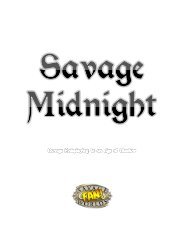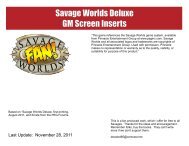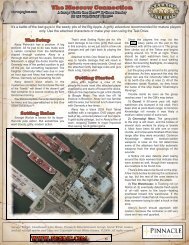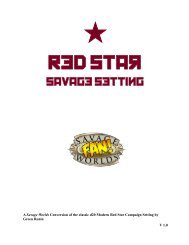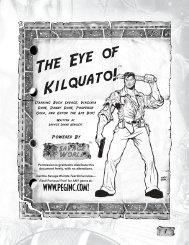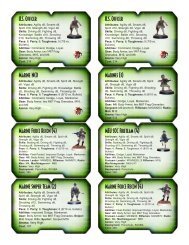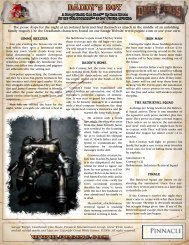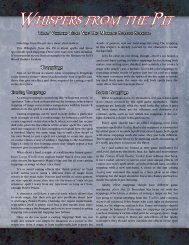Savage Worlds Free Bestiary - Savagepedia
Savage Worlds Free Bestiary - Savagepedia
Savage Worlds Free Bestiary - Savagepedia
You also want an ePaper? Increase the reach of your titles
YUMPU automatically turns print PDFs into web optimized ePapers that Google loves.
12.3. KILLER MOLD CHAPTER 12. K<br />
• Attributes: Agility d8, Smarts d4 (A), Spirit d10, Strength d4, Vigor<br />
d6<br />
• Skills: Fighting d6, Notice d6 Pace: 4 ; Parry: 5; Toughness: 3<br />
• Special Abilities:<br />
– Slow: On the ground, killer bees have Pace 4 and cannot run.<br />
– Flight: Killer bees have a Flying Pace of 8”, with an Acceleration<br />
of 4”.<br />
– Size –2<br />
– Fearless: Killer bees are immune to Fear, and they cannot be<br />
Taunted or Intimidated.<br />
– Sting: Str+d4, AP 2; if the bee strikes and causes at least a<br />
Shaken result, it buries it’s stinger into the target, pumping poison<br />
into the wound. The stinger remains in the wound, and the<br />
bee dies the next round. Removing the stinger does an additional<br />
2d4 damage to the victim’s base Toughness.<br />
– Poison: Anyone wounded or Shaken by the sting attack must<br />
make a Vigor roll or gain a level of Fatigue. They take an automatic<br />
wound in 1d6 minutes. A Healing roll at –2 prevents this<br />
secondary damage. Fatigue levels are recovered at the rate of<br />
one per day.<br />
12.3. Killer Mold<br />
Killer Mold is, like corrosive slime, an environmental hazard rather than a<br />
true monster. It can be found in patches of varying sizes (Small, Medium,<br />
or Large Burst Template), always underground, and usually scattered with<br />
bones and bits of stone and metal. A hero approaching a Killer Mold must<br />
make a Notice roll to spot the Mold in time to avoid the nasty consequences<br />
of stepping into it. The Notice roll is modified by lighting conditions and<br />
other cirucmstances, as usual.<br />
Any flesh, wood, leather, or other organic that comes in contact with<br />
the mold is attacked by a digestive enzyme doing 2d6 damage each round<br />
you’re in the mold and for 1d4 rounds after you’ve left. (It takes only one<br />
round for the enzyme to eat through a pair of boots and start attacking<br />
your feet!)<br />
The mold can be killed with fire; you can clear away a 1” section of it<br />
each round with a torch, and a Blast spell of sufficient size will wipe it out<br />
entirely. When burned, there’s a 1 in 6 chance the mold will release it’s<br />
one defense mechanism: a massive cloud of spores. These spread out in a<br />
radius around the mold (1” for Small, 2” for Medium, 4” for Large); anyone<br />
84




